Formula 1 in the USSR (23 pics + text)
 Bashny.Net
Bashny.Net
It seemed a little bit more and the Soviet Union will try their hand at racing royal ...

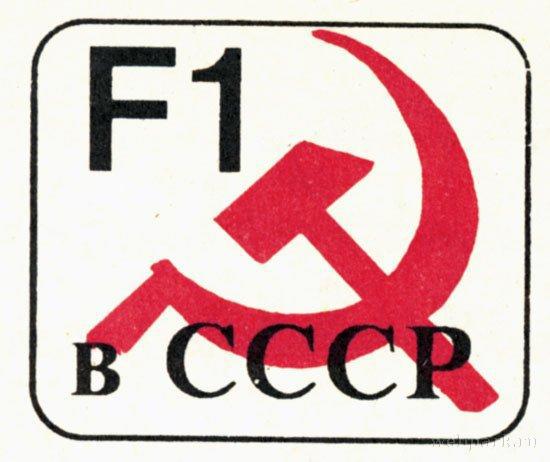
FIRST air attacks
Stalin's "Falcon" is going to hunt "STALLIONS" from Maranello
The hangar motorcycle team Force (Air Force), the Moscow Military District in the spring of 1952 were delivered to the two racing vehicles. Very soon, their bodies appeared the image of yellow-blue flag of the Air Force and the inscription "Falcon". The commander of the Moscow Military District Air Force, Lieutenant-General Vasily Stalin brought by plane from Chemnitz (GDR) two cars international formula 2. They designed a team of designers who have worked in the prewar period of racing cars "Auto Union". These highly qualified experts immediately after the war were united in science and technology bureau of the automobile (NTBA).
NTBA was one of the offices of the Soviet-German joint-stock company "Avtovelo" along with former BMW car plant in Eisenach and other enterprises. One of the work desk was the theme of "55A" ("Racing car in the class of 2-liter rear engine") - in other words, the car of Formula 2 (then called "Formula B"). This class of racing cars, according to the FIA, was to be the springboard for the athletes to the arena of Formula 1 cars and pool are not as powerful and expensive as those who play in the world championship. It was on such a structure and work NTBA, chief of which was the representative of the Soviet administration VG Myshkin, and acting director - German specialist I. Vittber.
At the time the World Cup was dominated by Italian riders on machines "Alfa Romeo" and "Ferrari". And when the first of these companies for financial reasons, decided not to start in the championship of 1952, it became clear that all the stages to win the drivers 'Ferrari' World Championship and become "a game with only one goal." And the FIA has decided to spend it on cars of Formula 2.
Car Formula B then there was a lot of "Ferrari", "Maserati", "Gordini», ERA, «Connaught», HWM, «Veritas Meteor», AWE - all with four or six-cylinder two-liter engine capacity of 155-175 liters. from. These models are built on the scheme with a front located engine and rear-wheel drive weighed 660-800 kilograms and can reach a maximum speed of 220-235 km / h.
Former experts of "Auto Union" were supporters of the rear-engined layout and 12-cylinder engines in the changed environment to speed up work on "55A", because they believed that their machines have a real chance.
On the territory of the GDR then you could find experienced riders to participate in World Championships in domestic machines. However, R. Krause, P. Grayftsu, K. Baum belonged to the older generation and their capabilities are not going to compare with the world's aces H.-M. Fangio, Farina and D. A. Askari. But on the sports scene appeared young, promising and X. Burt E. Melkus.
Model "650", designed and built "auto-unionovtsami" from the NTBA, March 31, 1952 made the first trial trips on the territory of the Bureau. To begin with no risk: traveled 10 kilometers, keeping revs above 3500, and not exceeding the speed of 115 km / h.
Began adjustment: selection of tire pressure, candles, fuel, ignition timing, engine test bench. We tried motors with four carburetors "Solex" mixing chambers which had a diameter of 19 mm - the engine is not developed more than 4500 rev / min. Set other "Solex" with the 23-mm cones - achieved 5,000 rev / min. We worked methodically, step by step, but without losing time - the first stage of the World Cup in 1952 was held May 18 in Bern, and the next - on June 22 in Spa. Another departure for tests so do not tighten. It took place on April 8. On the freeway near Bautzen traveled 60 kilometers. In some areas under the regime of 5000 rev / min was achieved speed of 175 km / h.
But soon came the order from the top: two cars packed and flown to Moscow at the disposal of the commander of the Air Force MVO V. Stalin.
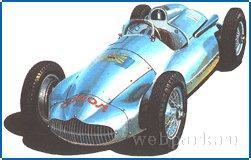
Ambitious plans to enter the arena of international racing, where Stalin's "Falcon" must be accompanied by victory, Hot imagination. But before you go abroad, Vasily I. nevertheless decided to try to "Sokol-650" on the 23 th kilometer of the Minsk highway near Moscow. There, near the village of Bakovka usually held car races. Do not ring, and the so-called "linear" when the athletes raced along the straight or nearly straight stretch of highway length of 100 or 150 kilometers, centered around tables labeled "turn" and raced back to the finish line. What kind of speeds they reached? On the 100-kilometer race in September 1951 Kharkov Vladimir Nikitin at the rear-streamlined car "Kharkiv-3" with engine capacity of 75 liters. from. has a top speed of 183, 964 km / h, and trehsotkilometrovoy - gorkovchanin Nikolai Sorokin driving "GAZ-Torpedo" with 2, 5-liter 105-horsepower engine has achieved a result of 165, 899 km / h.
While the riders and mechanics of the motorcycle team VVS MVO they settle in an unfamiliar car, on May 18 in Bern was the first stage of the world championship. Piero Taruffi won in the "Ferrari" with two-liter engine producing 160 hp. with showing the average speed of 143, 9 km / h, while the maximum was on the straight sections of 220 km / h.
Alas, among our athletes motorists that time, only four (Ambrosenko A. E. Laurent, I. Nikitin and Pomogaybo) on their machines a few times the speed of 200 km / h and the other racers rarely stepped over the barrier of 150 km / h, and then on the straights.
Lieutenant - General V. Stalin put two "Falcon-650" for the championship of Moscow June 30, 1952. They had to keep Pavel Baranov, then known motorcycle racer VVS MVO, and Vasily Kuznetsov, a skilled driver of the car.
Frilly flags 23rd kilometer of the Minsk highway in the morning waiting for the participants: they were 27 cars two classes. Eighteen crews (then spoke with the driver and mechanic) on the "Victory" and nine to the "Muscovites". Engines first developed capacity 70-78 liters. s second - 32-34 liters. from. Dvuhsotkilometrovuyu distance in class "victory" was the best L. Dashkov - 136, 560 km / h, and in the class of "Muscovites" - Gerasimov with the result of 113, 566 km / h. Thus ended the race, which in its status should have been "the big prize of Moscow».
And what about the "Falcons"? Alas, their engines did not want to work on all twelve cylinders. And fuel was not (the engine was designed for a complex alcohol mixture - because the compression ratio was 15: 5), and, apparently, the candles were not sufficiently cool (heat rating of 280), and the ignition timing ... In short, to adjust these machines have failed and they did not go.
But the temptation was very great. What's homemade machines Nikitin or Pomogaybo! "Falcon" -That with 152-horsepower engine was designed for 260 km / h. But, apparently, it was not destined to become his first Soviet car, which could start in the World Championships.
But, excuse me, why the Soviet? Because "Avtovelo" was born in 1946, when the GDR still existed. It was the Soviet occupation zone of Germany. And it is the Soviet-German society, which includes the NTBA, supplied the Soviet Union reparations cars BMW 321 and BMW 340, BMW R35 motorcycles. Thus, all its products (and the project of a racing car also) belonged to our country.
However, the summer of 1952 the Soviet government decided to transfer the ownership of the German Democratic Republic (this state was formed in October 1949), all joint ventures (including "Avtovelo"), together with their property. And the "Sokol" returned to their homeland. But time has already been lost and about any participation in the World Cup is not out of the question. NTBA reformed in the sectoral research institutes, funds for experiments with racing cars of Formula 2, the validity of which, incidentally, was due to expire at the end of 1953, was not. Machines have become museum exhibits transport in Dresden. Only once they are back on the race track - in 1959, when used as an automotive props in the film "The Rivals at the wheel" (and demonstrated in our country). There's "Falcon", slightly camouflaged, played the role of machines mythical Latin American team that is struggling at international races with the team of the GDR, serving on racing cars AWE.
When my time head of the design group race cars on MZMA (now AZLK) I was looking for any drawings, diagrams, sketches, photos of various racing cars and their components, in one of the cabinets blueprint department discovered a pile of old drawings. These blueprints were about 80 or 100 kilograms - all stamped "model 650". For my design work "Moskvich-G4" they are not of value - except for some size comparisons. But for the general education study of these blueprints was helpful. Something that I myself wrote a "reserve", photographed from reports NTBA (and they are also found) photo machines, met with a substantial volume of payments to the project "Falcon" (it was kept in the archive department chief designer MZMA).
And now about the car I know, probably a little more than the Peter Kirchberg, the author of a solid book "Grand Prix Report" Auto Union "for the years 1934-1939.". She went to East Germany the first edition in 1984, contain unique data throughout the race card "Auto Union", mentioned casually on the NTBA and his brainchild. The author claimed that the engine "Falcon" - increase of working volume (1482 to 1992 cm3) motor racing model "E", which "Auto Union" prepared in 1939 for the new polutoralitrovye racing formula. Meanwhile, both motors do not have a common base sizes. For example, "Auto Union-E" and "Falcon-650" with the same number of cylinders different angles collapse of blocks 60 and 65 °, respectively. And span cylinders (76 and 84 mm) and the diameter of the root and the crank pins of the crankshaft (55 and 50 mm), and the center distance of the connecting rod (130 and 128 mm) - different. In other words - the two designs, it is characterized by the "addition" of the most important dimensions of the original, but common in engineering handwriting at school.
Take the overall arrangement of "Falcon". The frame of the two spars (chrome tube diameter of 85 mm and a thickness of 2 mm) is identical in design to "Auto Union"., The power unit - just behind the rider. Similar in design to the front wheels and suspension. Location two onboard fuel tank, bodywork, a removable steering wheel, brake drums made of aluminum alloy and many other parts clearly outstanding design school "Auto Union».
The engine is less follows the tradition established in the racing department of the Saxon company. For example, the "Falcon" - the two camshafts (2ONS schemes) in the cylinder head, and the "Auto Union" - a structure in which the two heads were served by three "top" camshafts.
At the same time, both the engine - with a "wet cylinder liners in the cylinder block silumin, both - with two valves per cylinder and a circulation lubrication system.
As for the powertrain, the difference in everything: the material of the transaxle case and the main transfer (the "Falcon" - magnesium alloy, not silumin), the mutual arrangement of the box and the engine (the "Falcon" it between the engine and final drive), the presence of synchronizers (the "Auto Union" they are not), the type of the main transfer (the "Falcon" she hypoid and bevel gears are not).
In short, we can conclude that in the "Falcon" the basic concept of the school "Auto Union" preserved, but the solution of specific technical problems were different. Consequently, it is impossible to assert that "Falcon" - is a further development of the "Auto Union-E" (by the way, none of the sample it was not built).
In the analysis of the drawings "Falcon" I could not help comparing them with the design of "Auto Union", which was known to me, not only in the post-war reports us (the institute had several cars of eighteen, brought in 1945 in the USSR) on the books of L. Pomeroy and K. Adler. I got the impression that Myshkin had to supplement the initial state NTBA experts, far from the racing cars.
I think so, because the transfer of pushing and braking forces from the rear wheel to the frame "Falcon" was made at short cross forged levers associated with torsion, and A-shaped lever on the final drive - both car BMW-326 and in the style of "beemvistskih "Engineers. The engine was literally choked intake manifold through which the cylinders came from the mixture of four carburetors "Solex" - not six, as you would expect.
Too hard to get transmission. Although the cast magnesium alloy crankcase, its weight was 80 kg. It is appropriate to recall that the five-speed gearbox "Auto Union C", semi-detached from the main transmission was on 43 kg lighter, although transmit torque in 5, 3 times more than the "Falcon". Such an enormous difference - a result of the introduction of a box of "Falcon" four synchronizers, it is unnecessary for the race car. It seems that the transmission designed for passenger specialists rather than racing cars.
The same can be said of the engine. If you compare it with the 16-cylinder engine "Auto Union-On" (6010 cm3, 520 hp.), Equipped with a supercharger, we see that the power plant "Sokol", three times smaller in the working volume and develops in 3, 3 times less power, weigh 198 kilograms against 245 kilograms of the "Auto Union". The body, too, turned out to be heavier (55 kg against 34, 5).
In the end, it turned out Vittbera of overweight for his Formula racing car with an insufficient capacity. Even if the circumstances were favorable: Stalin Jr. have not shown interest in the car and went to the GDR team at the start of the championship, "Falcons" would not bring her good luck. The project was ambitious, but potentially losing. In addition, the car had to complete random carburetors and candles, as well as imported tires. In the GDR, the company "Riza" Only then did 16-inch racing tires.
For fans of motor sport in our country, "Falcons" were only in the memory of the witnesses of their only start for Moscow 41 years ago, but ten of his photographs of nodes placed in the now half-forgotten book Sabinin "fast cars", released in 1953, the publishing house "Physical education and Sports ". However, in Germany, this car does not have there no name or the factory brand, also is virtually unknown.
Leo Shugurov
"Falcon-650 'in all its glory: duralumin body, quick-" donut "acting" cheekbone "above-board fuel tank, 17-inch wheels," Rudge-Whitworth "with fastening of the central nut.

Each of the four carburetors "Solex" fed combustible mixture of three cylinders. The two magnetos (each service its number of cylinders) quoted from the rear ends of the intake camshaft

Front suspension - type "Porsche" in the transverse torsion bars. Shock absorbers - hydraulic lever. Water and oil radiators to come on the four rubber-canvas hose large diameter.

Transmission to the "Falcon" is not behind the main transmission, and in front of her. Along the tube frame is a longitudinal torsion bar suspension of the rear wheels. Aluminum brake drum is provided with ribs, and in which small holes are provided - also cooling air.
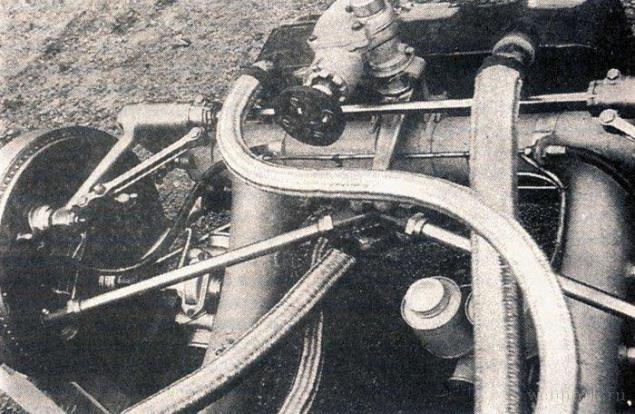
The rear wheels are connected by a tubular beam "De Dion". Reactive power is transmitted to the frame forged wishbones and torsion longitudinal wishbones. Shock absorbers - hydraulic lever.
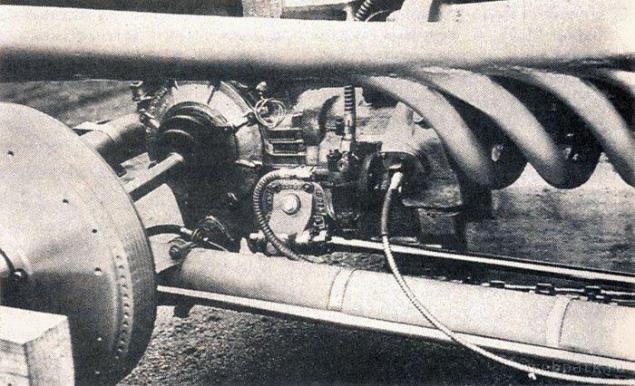
The first and the last start "Falcon" in racing. Yellow and blue stripes on the helmet of the rider saying that it is the Air Force command CVM.

Twelve-liter engine with four camshafts (two per cylinder block) vertical aluminum cylinder of (visible in the foreground) played the role of the expansion tank in the cooling system.

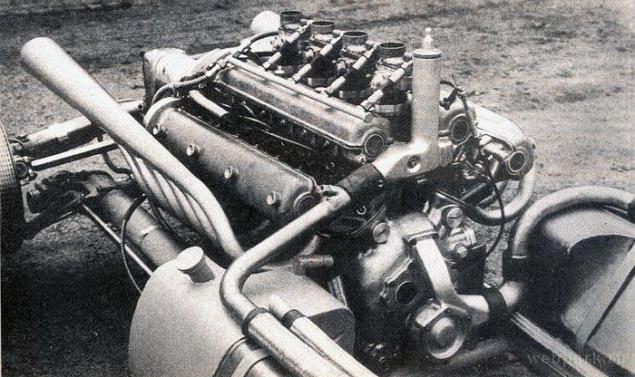
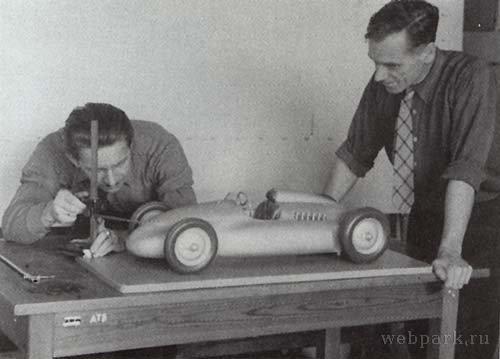
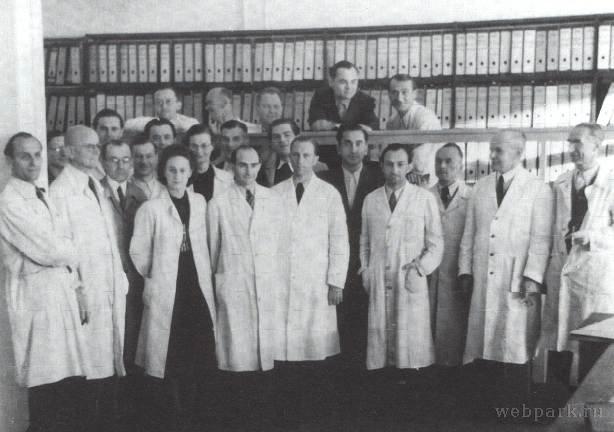


Technical characteristics of "Falcon-650»
General information: dry weight - 632 kg; curb weight (with dressing with water, fuel, oil) - 790 kg; weight distribution (with the driver) - 46% to the front wheels and 54% to the rear; fuel capacity 150 l; design speed - 260 or 275 km / h, depending on final drive ratio. Dimensions: length - 3800; width-1500; Height - 850; base - 2550; front track - 1240 mm, rear 1250; ground clearance - 125; Tire size: front - 5, 50-17, rear - 6 50 17 Engine: number of cylinders - 12; cylinder diameter - 62 mm; Stroke - 55 mm; Working bulk 1992 cm3; compression ratio - 15: 5; valve mechanism - 2ONS; carburetors - 4 single-chamber vertical "Solex-32"; Power 152 hp / 111 kW at 8000 rev / min; highest torque-16, 4-kg m at 4,000 rev / min; weight, 198 kg. Transmission stseplenie- two-disc, 197 mm in diameter in an oil bath; Transmission - 5-speed synchromesh on first gear 2-5; Power transmission range - 2, 2; final drive - hypoid gear ratio 4, 15, or 4, 583 Chassis: frame - spar of the pipes with a diameter of 85 mm;
from. from.
from.


FIRST air attacks
Stalin's "Falcon" is going to hunt "STALLIONS" from Maranello
The hangar motorcycle team Force (Air Force), the Moscow Military District in the spring of 1952 were delivered to the two racing vehicles. Very soon, their bodies appeared the image of yellow-blue flag of the Air Force and the inscription "Falcon". The commander of the Moscow Military District Air Force, Lieutenant-General Vasily Stalin brought by plane from Chemnitz (GDR) two cars international formula 2. They designed a team of designers who have worked in the prewar period of racing cars "Auto Union". These highly qualified experts immediately after the war were united in science and technology bureau of the automobile (NTBA).
NTBA was one of the offices of the Soviet-German joint-stock company "Avtovelo" along with former BMW car plant in Eisenach and other enterprises. One of the work desk was the theme of "55A" ("Racing car in the class of 2-liter rear engine") - in other words, the car of Formula 2 (then called "Formula B"). This class of racing cars, according to the FIA, was to be the springboard for the athletes to the arena of Formula 1 cars and pool are not as powerful and expensive as those who play in the world championship. It was on such a structure and work NTBA, chief of which was the representative of the Soviet administration VG Myshkin, and acting director - German specialist I. Vittber.
At the time the World Cup was dominated by Italian riders on machines "Alfa Romeo" and "Ferrari". And when the first of these companies for financial reasons, decided not to start in the championship of 1952, it became clear that all the stages to win the drivers 'Ferrari' World Championship and become "a game with only one goal." And the FIA has decided to spend it on cars of Formula 2.
Car Formula B then there was a lot of "Ferrari", "Maserati", "Gordini», ERA, «Connaught», HWM, «Veritas Meteor», AWE - all with four or six-cylinder two-liter engine capacity of 155-175 liters. from. These models are built on the scheme with a front located engine and rear-wheel drive weighed 660-800 kilograms and can reach a maximum speed of 220-235 km / h.
Former experts of "Auto Union" were supporters of the rear-engined layout and 12-cylinder engines in the changed environment to speed up work on "55A", because they believed that their machines have a real chance.
On the territory of the GDR then you could find experienced riders to participate in World Championships in domestic machines. However, R. Krause, P. Grayftsu, K. Baum belonged to the older generation and their capabilities are not going to compare with the world's aces H.-M. Fangio, Farina and D. A. Askari. But on the sports scene appeared young, promising and X. Burt E. Melkus.
Model "650", designed and built "auto-unionovtsami" from the NTBA, March 31, 1952 made the first trial trips on the territory of the Bureau. To begin with no risk: traveled 10 kilometers, keeping revs above 3500, and not exceeding the speed of 115 km / h.
Began adjustment: selection of tire pressure, candles, fuel, ignition timing, engine test bench. We tried motors with four carburetors "Solex" mixing chambers which had a diameter of 19 mm - the engine is not developed more than 4500 rev / min. Set other "Solex" with the 23-mm cones - achieved 5,000 rev / min. We worked methodically, step by step, but without losing time - the first stage of the World Cup in 1952 was held May 18 in Bern, and the next - on June 22 in Spa. Another departure for tests so do not tighten. It took place on April 8. On the freeway near Bautzen traveled 60 kilometers. In some areas under the regime of 5000 rev / min was achieved speed of 175 km / h.
But soon came the order from the top: two cars packed and flown to Moscow at the disposal of the commander of the Air Force MVO V. Stalin.

Ambitious plans to enter the arena of international racing, where Stalin's "Falcon" must be accompanied by victory, Hot imagination. But before you go abroad, Vasily I. nevertheless decided to try to "Sokol-650" on the 23 th kilometer of the Minsk highway near Moscow. There, near the village of Bakovka usually held car races. Do not ring, and the so-called "linear" when the athletes raced along the straight or nearly straight stretch of highway length of 100 or 150 kilometers, centered around tables labeled "turn" and raced back to the finish line. What kind of speeds they reached? On the 100-kilometer race in September 1951 Kharkov Vladimir Nikitin at the rear-streamlined car "Kharkiv-3" with engine capacity of 75 liters. from. has a top speed of 183, 964 km / h, and trehsotkilometrovoy - gorkovchanin Nikolai Sorokin driving "GAZ-Torpedo" with 2, 5-liter 105-horsepower engine has achieved a result of 165, 899 km / h.
While the riders and mechanics of the motorcycle team VVS MVO they settle in an unfamiliar car, on May 18 in Bern was the first stage of the world championship. Piero Taruffi won in the "Ferrari" with two-liter engine producing 160 hp. with showing the average speed of 143, 9 km / h, while the maximum was on the straight sections of 220 km / h.
Alas, among our athletes motorists that time, only four (Ambrosenko A. E. Laurent, I. Nikitin and Pomogaybo) on their machines a few times the speed of 200 km / h and the other racers rarely stepped over the barrier of 150 km / h, and then on the straights.
Lieutenant - General V. Stalin put two "Falcon-650" for the championship of Moscow June 30, 1952. They had to keep Pavel Baranov, then known motorcycle racer VVS MVO, and Vasily Kuznetsov, a skilled driver of the car.
Frilly flags 23rd kilometer of the Minsk highway in the morning waiting for the participants: they were 27 cars two classes. Eighteen crews (then spoke with the driver and mechanic) on the "Victory" and nine to the "Muscovites". Engines first developed capacity 70-78 liters. s second - 32-34 liters. from. Dvuhsotkilometrovuyu distance in class "victory" was the best L. Dashkov - 136, 560 km / h, and in the class of "Muscovites" - Gerasimov with the result of 113, 566 km / h. Thus ended the race, which in its status should have been "the big prize of Moscow».
And what about the "Falcons"? Alas, their engines did not want to work on all twelve cylinders. And fuel was not (the engine was designed for a complex alcohol mixture - because the compression ratio was 15: 5), and, apparently, the candles were not sufficiently cool (heat rating of 280), and the ignition timing ... In short, to adjust these machines have failed and they did not go.
But the temptation was very great. What's homemade machines Nikitin or Pomogaybo! "Falcon" -That with 152-horsepower engine was designed for 260 km / h. But, apparently, it was not destined to become his first Soviet car, which could start in the World Championships.
But, excuse me, why the Soviet? Because "Avtovelo" was born in 1946, when the GDR still existed. It was the Soviet occupation zone of Germany. And it is the Soviet-German society, which includes the NTBA, supplied the Soviet Union reparations cars BMW 321 and BMW 340, BMW R35 motorcycles. Thus, all its products (and the project of a racing car also) belonged to our country.
However, the summer of 1952 the Soviet government decided to transfer the ownership of the German Democratic Republic (this state was formed in October 1949), all joint ventures (including "Avtovelo"), together with their property. And the "Sokol" returned to their homeland. But time has already been lost and about any participation in the World Cup is not out of the question. NTBA reformed in the sectoral research institutes, funds for experiments with racing cars of Formula 2, the validity of which, incidentally, was due to expire at the end of 1953, was not. Machines have become museum exhibits transport in Dresden. Only once they are back on the race track - in 1959, when used as an automotive props in the film "The Rivals at the wheel" (and demonstrated in our country). There's "Falcon", slightly camouflaged, played the role of machines mythical Latin American team that is struggling at international races with the team of the GDR, serving on racing cars AWE.
When my time head of the design group race cars on MZMA (now AZLK) I was looking for any drawings, diagrams, sketches, photos of various racing cars and their components, in one of the cabinets blueprint department discovered a pile of old drawings. These blueprints were about 80 or 100 kilograms - all stamped "model 650". For my design work "Moskvich-G4" they are not of value - except for some size comparisons. But for the general education study of these blueprints was helpful. Something that I myself wrote a "reserve", photographed from reports NTBA (and they are also found) photo machines, met with a substantial volume of payments to the project "Falcon" (it was kept in the archive department chief designer MZMA).
And now about the car I know, probably a little more than the Peter Kirchberg, the author of a solid book "Grand Prix Report" Auto Union "for the years 1934-1939.". She went to East Germany the first edition in 1984, contain unique data throughout the race card "Auto Union", mentioned casually on the NTBA and his brainchild. The author claimed that the engine "Falcon" - increase of working volume (1482 to 1992 cm3) motor racing model "E", which "Auto Union" prepared in 1939 for the new polutoralitrovye racing formula. Meanwhile, both motors do not have a common base sizes. For example, "Auto Union-E" and "Falcon-650" with the same number of cylinders different angles collapse of blocks 60 and 65 °, respectively. And span cylinders (76 and 84 mm) and the diameter of the root and the crank pins of the crankshaft (55 and 50 mm), and the center distance of the connecting rod (130 and 128 mm) - different. In other words - the two designs, it is characterized by the "addition" of the most important dimensions of the original, but common in engineering handwriting at school.
Take the overall arrangement of "Falcon". The frame of the two spars (chrome tube diameter of 85 mm and a thickness of 2 mm) is identical in design to "Auto Union"., The power unit - just behind the rider. Similar in design to the front wheels and suspension. Location two onboard fuel tank, bodywork, a removable steering wheel, brake drums made of aluminum alloy and many other parts clearly outstanding design school "Auto Union».
The engine is less follows the tradition established in the racing department of the Saxon company. For example, the "Falcon" - the two camshafts (2ONS schemes) in the cylinder head, and the "Auto Union" - a structure in which the two heads were served by three "top" camshafts.
At the same time, both the engine - with a "wet cylinder liners in the cylinder block silumin, both - with two valves per cylinder and a circulation lubrication system.
As for the powertrain, the difference in everything: the material of the transaxle case and the main transfer (the "Falcon" - magnesium alloy, not silumin), the mutual arrangement of the box and the engine (the "Falcon" it between the engine and final drive), the presence of synchronizers (the "Auto Union" they are not), the type of the main transfer (the "Falcon" she hypoid and bevel gears are not).
In short, we can conclude that in the "Falcon" the basic concept of the school "Auto Union" preserved, but the solution of specific technical problems were different. Consequently, it is impossible to assert that "Falcon" - is a further development of the "Auto Union-E" (by the way, none of the sample it was not built).
In the analysis of the drawings "Falcon" I could not help comparing them with the design of "Auto Union", which was known to me, not only in the post-war reports us (the institute had several cars of eighteen, brought in 1945 in the USSR) on the books of L. Pomeroy and K. Adler. I got the impression that Myshkin had to supplement the initial state NTBA experts, far from the racing cars.
I think so, because the transfer of pushing and braking forces from the rear wheel to the frame "Falcon" was made at short cross forged levers associated with torsion, and A-shaped lever on the final drive - both car BMW-326 and in the style of "beemvistskih "Engineers. The engine was literally choked intake manifold through which the cylinders came from the mixture of four carburetors "Solex" - not six, as you would expect.
Too hard to get transmission. Although the cast magnesium alloy crankcase, its weight was 80 kg. It is appropriate to recall that the five-speed gearbox "Auto Union C", semi-detached from the main transmission was on 43 kg lighter, although transmit torque in 5, 3 times more than the "Falcon". Such an enormous difference - a result of the introduction of a box of "Falcon" four synchronizers, it is unnecessary for the race car. It seems that the transmission designed for passenger specialists rather than racing cars.
The same can be said of the engine. If you compare it with the 16-cylinder engine "Auto Union-On" (6010 cm3, 520 hp.), Equipped with a supercharger, we see that the power plant "Sokol", three times smaller in the working volume and develops in 3, 3 times less power, weigh 198 kilograms against 245 kilograms of the "Auto Union". The body, too, turned out to be heavier (55 kg against 34, 5).
In the end, it turned out Vittbera of overweight for his Formula racing car with an insufficient capacity. Even if the circumstances were favorable: Stalin Jr. have not shown interest in the car and went to the GDR team at the start of the championship, "Falcons" would not bring her good luck. The project was ambitious, but potentially losing. In addition, the car had to complete random carburetors and candles, as well as imported tires. In the GDR, the company "Riza" Only then did 16-inch racing tires.
For fans of motor sport in our country, "Falcons" were only in the memory of the witnesses of their only start for Moscow 41 years ago, but ten of his photographs of nodes placed in the now half-forgotten book Sabinin "fast cars", released in 1953, the publishing house "Physical education and Sports ". However, in Germany, this car does not have there no name or the factory brand, also is virtually unknown.
Leo Shugurov
"Falcon-650 'in all its glory: duralumin body, quick-" donut "acting" cheekbone "above-board fuel tank, 17-inch wheels," Rudge-Whitworth "with fastening of the central nut.

Each of the four carburetors "Solex" fed combustible mixture of three cylinders. The two magnetos (each service its number of cylinders) quoted from the rear ends of the intake camshaft

Front suspension - type "Porsche" in the transverse torsion bars. Shock absorbers - hydraulic lever. Water and oil radiators to come on the four rubber-canvas hose large diameter.

Transmission to the "Falcon" is not behind the main transmission, and in front of her. Along the tube frame is a longitudinal torsion bar suspension of the rear wheels. Aluminum brake drum is provided with ribs, and in which small holes are provided - also cooling air.

The rear wheels are connected by a tubular beam "De Dion". Reactive power is transmitted to the frame forged wishbones and torsion longitudinal wishbones. Shock absorbers - hydraulic lever.

The first and the last start "Falcon" in racing. Yellow and blue stripes on the helmet of the rider saying that it is the Air Force command CVM.

Twelve-liter engine with four camshafts (two per cylinder block) vertical aluminum cylinder of (visible in the foreground) played the role of the expansion tank in the cooling system.






Technical characteristics of "Falcon-650»
General information: dry weight - 632 kg; curb weight (with dressing with water, fuel, oil) - 790 kg; weight distribution (with the driver) - 46% to the front wheels and 54% to the rear; fuel capacity 150 l; design speed - 260 or 275 km / h, depending on final drive ratio. Dimensions: length - 3800; width-1500; Height - 850; base - 2550; front track - 1240 mm, rear 1250; ground clearance - 125; Tire size: front - 5, 50-17, rear - 6 50 17 Engine: number of cylinders - 12; cylinder diameter - 62 mm; Stroke - 55 mm; Working bulk 1992 cm3; compression ratio - 15: 5; valve mechanism - 2ONS; carburetors - 4 single-chamber vertical "Solex-32"; Power 152 hp / 111 kW at 8000 rev / min; highest torque-16, 4-kg m at 4,000 rev / min; weight, 198 kg. Transmission stseplenie- two-disc, 197 mm in diameter in an oil bath; Transmission - 5-speed synchromesh on first gear 2-5; Power transmission range - 2, 2; final drive - hypoid gear ratio 4, 15, or 4, 583 Chassis: frame - spar of the pipes with a diameter of 85 mm;
from. from.
from.
Tags
See also
Airport from the perspective of the aircraft. Part 2 (35 pics + text)
Airport from the perspective of the aircraft. Part 1 (39 pics + text)
Airport in terms of the manager (33 pics + text)
Airport in terms of tomatoes (41 pics + text)
Airport from the point of view of the pilot (44 pics + text)
The Americans crossed the border of the USSR (4 photos)
How things work: Work trauma (3 pics + text)
How things work: Trading in subway trains (2 pics + text)
Country sick megalomaniac (5 pics + text)
As now depict life in the USSR (2 photos)

















